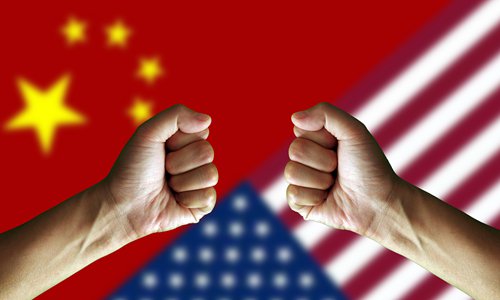HOME >> OPINION
No need to overreact as Quad ups gear
By Zhao Minghao Source:Global Times Published: 2019/9/29 19:43:39

Photo: IC
The Quadrilateral Security Dialogue - known as Quad - between the US, Japan, India and Australia was held Thursday on the sidelines of the UN General Assembly at the foreign minister's level.
Since its revival in November 2017, the Quad had met only at the joint-secretary level. This first foreign-minister-level meeting may suggest that the framework is upgrading. Speculation is swirling on whether it would move toward a NATO-like group in Asia.
US Secretary of State Mike Pompeo tweeted that they "discussed our shared interest in building a free and open #IndoPacific, denuclearization of #NorthKorea, and joint efforts to promote regional stability." But some Western media have suggested the meeting was mainly a bid to counter China's growing might.
The Trump administration has been promoting its "free and open" Indo-Pacific Strategy over the past two years. Seen as an extension of Barack Obama's Rebalance Strategy toward the Asia-Pacific, it continues to strengthen US containment of China and emphasize India's role.
New Delhi's policy adjustment undoubtedly was a key factor in upgrading the Quad. Since Trump assumed office, US-India ties have been further enhanced. The US sees India not only as a major power in Indo-Pacific, but also a friend to compete with China at the global level.
With its nationalist feature and religious policies, Indian Prime Minister Narendra Modi's government has found chemistry with the Trump administration to some extent. Modi's recent visit to the US was an example. Trump praised Modi as "one of America's greatest, most devoted and most loyal friends" at the "Howdy, Modi!" event in Texas on September 22. New Delhi has been treated by Washington almost as an ally in terms of defense technology and access to advanced weapons.
But New Delhi has long been seeking a balance between the US and China. It loathes to lose its strategic autonomy or become a sidekick of the US. In particular, Modi has proposed a different Indo-Pacific vision from the US one.
The 2017 US Security Strategy described Indo-Pacific as a region where "geopolitical competition between free and repressive visions of world order is taking place," and accused China of seeking regional hegemony. But Modi told the Shangri-La Dialogue in June 2018 that "India does not see the Indo-Pacific region as a strategy or as a club of limited members. And by no means do we consider it as directed against any country." Obviously, New Delhi is unwilling to feature this region with competition against China.
Indian external affairs minister Subrahmanyam Jaishankar said in June at a press meeting that "The Indo-Pacific is for something, not against somebody. And that something is peace, security, stability, prosperity and rules."
It has been reported by the Times of India that Chinese President Xi Jinping is to visit India for an informal meeting with Modi in October, after the Wuhan tete-a-tete in China in April 2018, an unusual diplomatic move between the two sides to enhance trust and manage differences.
The most essential driver for upgrading the Quad comes from the US. The US Defense Department in June issued the first Indo-Pacific Strategy report, which is widely regarded as a signal that the Trump administration will further strengthen its strategic competition with China in the region.
For Washington, the Quad is a core mechanism for implementing its Indo-Pacific Strategy, and a basis for building a "NATO" in Asia to contain Beijing. Through Quad, it can better integrate its existing two trilateral mechanisms - one between US, Japan and Australia, the other between US, Japan and India. In addition, Washington also hopes to conduct the US-Japan-India-Australia joint patrols in the South China Sea and to establish a stronger regional missile defense system.
But the Trump administration's attempt to build a "NATO" in Asia is doomed to face setbacks. After all, Japan, Australia and India are unwilling to confront China and cannot afford the tremendous cost it brings. By advancing the third-party market cooperation with Beijing, Tokyo is exploring a new path to respond to the China-proposed Belt and Road Initiative.
During his visit to the US, Australian Prime Minister Scott Morrison on September 23 also stressed Canberra's "strategic and comprehensive partnerships" with Beijing and said, "China's economic growth is welcomed by Australia."
The Modi administration also prefers not to confuse Quad with the Indo-Pacific Strategy and hopes to consolidate its position in Eurasia by means of the India-China-Russia trilateral mechanism.
In summary, although the upgrade of Quad might make Beijing uneasy, it is not surprising, because this is partly a result of the deepened US-China strategic competition. Most Chinese observers believe that there is no need to overreact, and the key to handling the Quad is to be more active in dealing with India, Japan and Australia.
The author is a senior research fellow at the Charhar Institute and an adjunct fellow at the Chongyang Institute for Financial Studies at Renmin University of China. opinion@globaltimes.com.cn
RELATED ARTICLES:
Posted in: ASIAN REVIEW